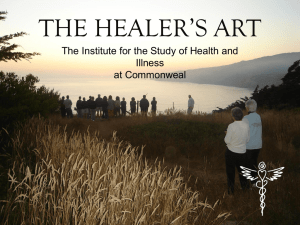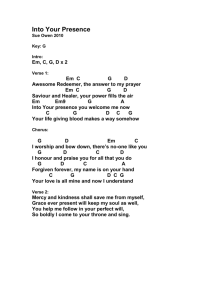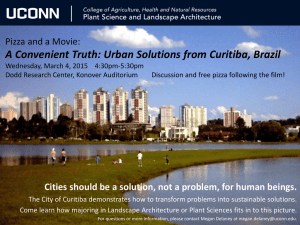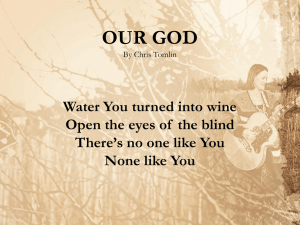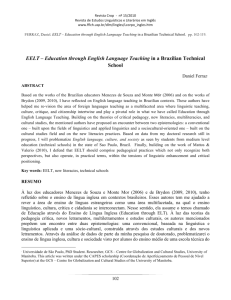171 HISTORICAL ROOTS OF MUSIC THERAPY: A BRIEF
advertisement
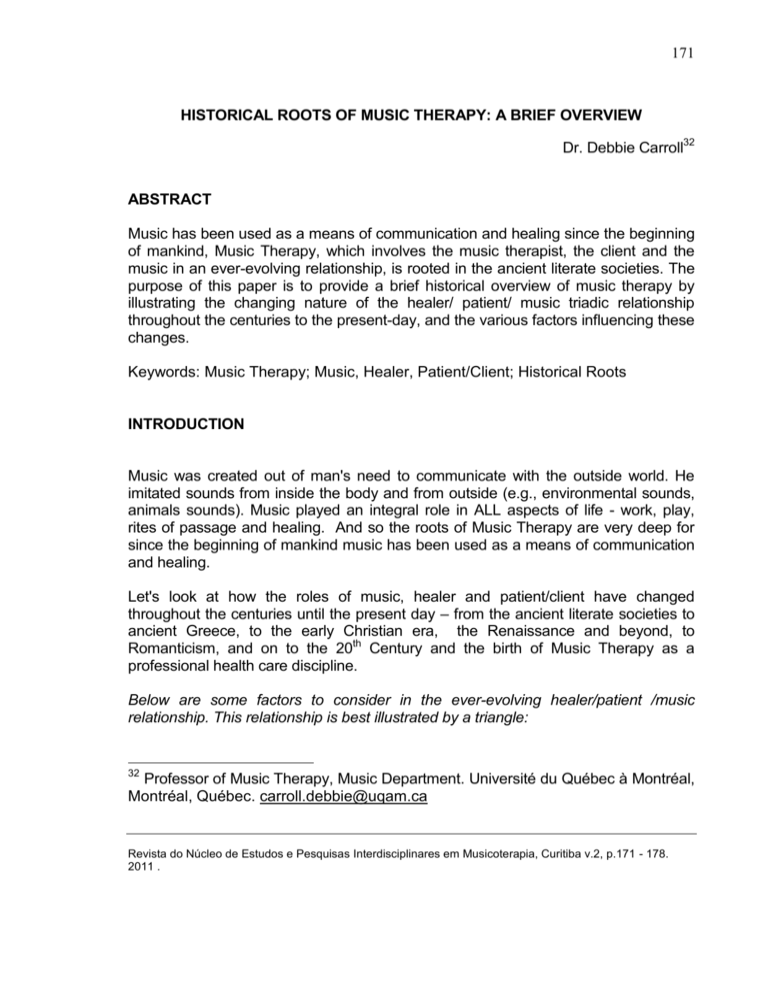
171
HISTORICAL ROOTS OF MUSIC THERAPY: A BRIEF OVERVIEW
Dr. Debbie Carroll32
ABSTRACT
Music has been used as a means of communication and healing since the beginning
of mankind, Music Therapy, which involves the music therapist, the client and the
music in an ever-evolving relationship, is rooted in the ancient literate societies. The
purpose of this paper is to provide a brief historical overview of music therapy by
illustrating the changing nature of the healer/ patient/ music triadic relationship
throughout the centuries to the present-day, and the various factors influencing these
changes.
Keywords: Music Therapy; Music, Healer, Patient/Client; Historical Roots
INTRODUCTION
Music was created out of man's need to communicate with the outside world. He
imitated sounds from inside the body and from outside (e.g., environmental sounds,
animals sounds). Music played an integral role in ALL aspects of life - work, play,
rites of passage and healing. And so the roots of Music Therapy are very deep for
since the beginning of mankind music has been used as a means of communication
and healing.
Let's look at how the roles of music, healer and patient/client have changed
throughout the centuries until the present day – from the ancient literate societies to
ancient Greece, to the early Christian era, the Renaissance and beyond, to
Romanticism, and on to the 20th Century and the birth of Music Therapy as a
professional health care discipline.
Below are some factors to consider in the ever-evolving healer/patient /music
relationship. This relationship is best illustrated by a triangle:
32
Professor of Music Therapy, Music Department. Université du Québec à Montréal,
Montréal, Québec. carroll.debbie@uqam.ca
Revista do Núcleo de Estudos e Pesquisas Interdisciplinares em Musicoterapia, Curitiba v.2, p.171 - 178.
2011 .
172
Music
Healer
Patient
Healer ~ personality and healer’s role in community; musical skills and knowledge;
existing beliefs and theories regarding the nature and cause of the patient’s illness;
role of music in its treatment; philosophy and values.
Patient ~ nature of problem(s); willingness to be treated; musical (and non-musical)
responses
Music ~ style; instruments; pre-composed or improvised; particular use of the
musical elements (e.g., rhythm, melody, harmony, dynamics, timbre, form)
ANTIQUITY and ANCIENT SOCIETIES
During ANTIQUITY and ANCIENT SOCIETIES (a period lasting about 500,000
years), the SHAMAN used music in magico-religious rituals to purge the evil spirits
from the sick person's body. Through music and dance, the patient reached a state
of trance and ecstasy, allowing for catharsis/purification and healing.
The famous story in the Old Testament of young David, the Israelite (born around
1037 BC), playing the lyre for King Saul, who was tormented by an evil spirit
(chronic depression, melancholy), must be mentioned here. Why? Because David
was not concerned with communicating with the gods or spirits to purge King Saul
of his illness; rather David was playing music for King Saul in an attentive,
empathic manner. In so doing, David is often considered the first music therapist.
Revista do Núcleo de Estudos e Pesquisas Interdisciplinares em Musicoterapia, Curitiba v.2, p.171 - 178.
2011 .
173
Music
Shaman
Patient
Healer ~ SHAMAN / MEDICINEMAN / TRIBAL MUSICIAN - outcast, congenital
anomaly, admired and revered, possessed specific musical knowledge and secret
rhythmic patterns which were used to appease, communicate with, dominate and
finally exorcise the spirits of illness within the sick person's body. Instruments were
believed to be a go-between the concrete and spiritual world, and endowed with
divine power because they were made with once-living materials (e.g., bones, wood,
ebony, ivory).
Patient ~ possessed by an evil spirit or victim of an enemy's spell; fearful,
dependent, out of control
Music ~ energetic (biorhythms: quarter note =72,or doubled = 144). Drums, rattles
and chants were used. Family and other select members of the community were
often part of the ‘orchestra’. Specific rhythms were used, based on the secret
patterns associated with the spirits (e.g., fever spirit slow and simple rhythmic
patterns to decrease body temperature; rheumatoid spirit quicker and more
complex rhythmic patterns to increase body temperature.
ANCIENT GREECE
During ANCIENT GREECE (600 B.C ), the Greek PRIEST used music to evoke
specific emotions, build character and restore order between the body and soul. As
in the ancient cultures of China, Egypt, and India, there existed in Greece a
common belief that music had a fundamental power to either uplift or degrade, and
thus enhance or corrupt entire civilizations. As Plato (428 BC-348 BC), one of the
world's most influential philosophers, stated in the Republic (written around 380
BC): “Music moulds character, when modes of music change, the fundamental laws
Revista do Núcleo de Estudos e Pesquisas Interdisciplinares em Musicoterapia, Curitiba v.2, p.171 - 178.
2011 .
174
of the state change with them." He also wrote that "Music is medicine to the soul"
and "Justice is to the soul as health is to the body. Through music, the soul learns
harmony and rhythm and even a disposition to justice."
During this era, rational medicine gradually replaced the
magico-religious nature of healing, as clearly reflected in Apollo,
who was the Greek god of music and medicine.
Music
Priest
Patient
Healer ~ PRIEST – respected but not loved; the role of priest was
inherited by casting lots; used specific musical modes to restore
harmony between the body and soul.
Patient ~ considered inferior; emotional problems; guilty of committing a sin or
breaking the law.
Music ~ use of specific musical modes to effect desired changes in the patient’s
state, and in society at large. For example, the Dorian mode (associated with
Athens) was believed to evoke purity and contemplation. The Phrygian mode
(associated with Troy) was considered the warlike mode and used to stimulate
combat. The elements of music were also used in conscious ways - harmony evoked
spiritual feelings; melody appealed to the emotions, and rhythm appealed to the
body.
Revista do Núcleo de Estudos e Pesquisas Interdisciplinares em Musicoterapia, Curitiba v.2, p.171 - 178.
2011 .
175
EARLY CHRISTIAN ERA
During the EARLY CHRISTIAN ERA (476-1450 AD), the PRIEST used music, in
particular, hymns, to provide a spiritual experience that transcended the feeling of
pain and offered hope. With the help of hymn specialists, or aretologists, priests
sang hymns to ease the sick man's suffering and create heaven on earth. The
notion of an evil spirit that must be exorcised was being replaced by a loving god,
full of goodness and caring towards the patient. Sadly, however, individuals
considered to be mentally ill, were incarcerated, abused, and believed to be
possessed by demons.
Music
Priest
Patient
Healer ~ PRIEST – like a father figure, loving and compassionate; saw in the patient
a weak, mortal body, and an immortal soul to be saved; music was used as a
message of hope.
Patient ~ accepting, grateful and humbled before a loving god; this
was not the case for those perceived to be mentally ill .
Music ~ hymns; melodic element dominated to convey the idea of floating up to
heaven. Instruments such as the flute, harp, drum and the trumpet, were outlawed
because they were associated with pagan worship and loose morals of secular life.
RENAISSANCE AND BEYOND
During the time of the RENAISSANCE AND BEYOND (1580-1750 AD), the
PHYSICIAN used music to effect desired emotional and physiological changes.
Exciting advances in medicine, especially in anatomy and physiology (e.g., Harvey
and his work on the circulation of the blood), marked the beginnings of the scientific,
Revista do Núcleo de Estudos e Pesquisas Interdisciplinares em Musicoterapia, Curitiba v.2, p.171 - 178.
2011 .
176
cause -and-effect approach. Athanasius Kircher’s theory of temperaments and
affections, which go back to Greek medical theory, dominated the medical practice of
the day. According to this theory, there are four human temperaments/ personality
types - sanguine, melancholic, choleric, phlegmatic. Each is associated with one of
the 4 body juices, or humours – blood, yellow bile, black bile, phlegm – and one of
the 4 elements – air, fire, earth and water. According to the beliefs of the day, illness
was a result of biochemical disturbances, namely the imbalance of one of more of
the body juices. Music was believed to have an influence on the nervous system,
resulting in a return to harmony of the body juices. The French philosopher, René
Descartes (1596-1650) also observed the effect of musical intervals on emotional
states, For example, large intervals stimulate and create tension; descending
intervals calm and encourage contemplation .
Healer ~ PHYSICIAN – influenced by new advances in medicine and the theory of
the four temperaments; used different proportions of the musical elements to affect
breathing, pulse, blood pressure and metabolic rate in different ways; also used
music to evoke certain emotions.
Patient ~ emotional problems (e.g., melancholy) or physical problems.
Music ~ music listening or music-making; music with a slow tempo, regular pulse
and extended melodic lines used to induce a relaxed state; music with frequent
tempo changes, rhythmic variety and short melodic phrases used to induce a more
active state.
ROMANTIC ERA
During the ROMANTIC ERA (2nd half of 18th C. – early 20th C.), the PHYSICIANMUSICIAN used music listening, active music-making, and live musical
performances in their work with patients of all ages and disabilities.
Music
Physician/Musician
Patient
Revista do Núcleo de Estudos e Pesquisas Interdisciplinares em Musicoterapia, Curitiba v.2, p.171 - 178.
2011 .
177
Healer ~ PHYSICIAN/MUSICIAN - beginning to recognize need for specific musical
skill on the part of the healer and for assessment of patient’s musical sensitivity.
Patient ~ increasing number of disabilities, settings and ages including children with
sensory handicaps (e.g., visual and/or auditory impairments)
Music ~ music listening, music-making, live concerts for large groups of patients with
mental illnesses.
TWENTIETH CENTURY ~ BIRTH OF MUSIC THERAPY AS A PROFESSIONAL
HEALTH CARE DISCIPLINE
Rapid urbanization resulted in large mental hospitals. One attempt to turn these
mental asylums into active treatment centres was through music played by hospital
and community musicians. Furthermore, with the return of World War II veterans
traumatized by their horrific war experiences, and their remarkable responses to
music, there was a growing interest in the therapeutic and rehabilitative value of
music – both live and recorded (thanks to Edison's invention of the phonograph in
1877). At the same time, an increasing number of publications were presenting the
case for music therapy and for training music therapists who were able to use
specific music skills in the assessment and treatment of patients of all ages and
presenting a wide range of disabilities.
Music
Music Therapist
Patient
The need for specially trained music therapists was realized in 1944 with the
establishment of the first training program at Michigan State University. In 1950 the
first Association for Music Therapy was founded in the United States, and in 2010,
the American Music Therapy Association celebrated 60 years of development and
growth. With the subsequent development of music therapy training programs
worldwide, Music Therapy has become a recognized professional health care
Revista do Núcleo de Estudos e Pesquisas Interdisciplinares em Musicoterapia, Curitiba v.2, p.171 - 178.
2011 .
178
discipline. For information on the state of music therapy throughout the world, go to
www.voices.no {World Forum for Music Therapy}.
Music Therapists draw from ancient healing traditions and from evidence -based
research on the behavioural and cognitive effects of music (behaviour-oriented
music therapy), the physiological effects of music (medical model of music therapy)
and the psychological effects (insight-oriented music therapy ~ psychodynamic,
analytical). Kenneth Bruscia, a key player and prolific writer in the field of music
therapy, provides a definition of music therapy in his book, Defining Music Therapy,
which has been translated into six languages ~ German, Italian, Japanese,
Portuguese and Spanish:
“Music therapy is a systematic process of intervention wherein the
therapist helps the client to promote health, using music experiences
and the relationships that develop through them as dynamic forces of
change.”
(1998, p.20)
REFERENCES
Bruscia, K. (1996). Defining Music Therapy. Gilsum, NH: Barcelona Publishers.
Davis, W. & Gfeller, K. (2008). Music therapy: An historical perspective. In W.
Davis, K.Gfeller and M.Thaut (Eds.), Introduction to Music Therapy: Theory
and Practice (pp. 16-33), Silver Spring, MD: American Music Therapy Association.
Hall, M.P. (1982). The therapeutic value of music including the philosophy of
music. Los Angeles, CA: Philosophical Research Society.
Horden, P. (Ed.) (2000). Music as medicine : The history of music therapy since
antiquity. Aldershot, UK: Ashgate.
Voices: A World Forum for Music Therapy – www.voices.no
Recebido: 13/06/2011
Aprovado: 21/06/2011
Revista do Núcleo de Estudos e Pesquisas Interdisciplinares em Musicoterapia, Curitiba v.2, p.171 - 178.
2011 .
